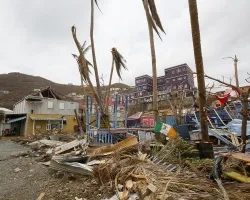Earth-observing instruments on satellites and aircraft are mapping the current fires, providing data products to agencies on the ground that are responding to the emergency.
As California experiences one of the worst wildfire seasons on record, NASA is leveraging its resources to help. Scientists supporting the agency's Applied Sciences Disaster Program in the Earth Sciences Division are generating maps and other data products that track active fires and their smoke plumes while also identifying areas that may be susceptible to future risks.
"When disasters like this occur, we are able to swiftly respond to requests from our partners who need images and mapping data," said David Green, manager of the Disasters Program at NASA Headquarters in Washington. "Likewise, in the aftermath of the fires, our researchers will use orbital and aerial data of the burn areas to help mitigate hazards such as landslides and mudslides."
Most of the data comes from the numerous satellite instruments that pass over the state, such as the MOderate Resolution Imaging Spectroradiometer (MODIS) instruments aboard the Aqua and Terra satellites, the Visible Infrared Imaging Radiometer Suite (VIIRS) instruments aboard the Suomi-NPP satellite, and the Cloud-Aerosol Lidar with Orthogonal Polarization (CALIOP) instrument onboard the CALIPSO satellite.
Another such instrument is the Advanced Spaceborne Thermal Emission and Reflection Radiometer (ASTER) instrument aboard the Terra satellite. Managed by Japan Space Systems and NASA's Jet Propulsion Laboratory in Southern California, ASTER views Earth's surface in visible, near-infrared, and thermal-infrared wavelengths, allowing features such as the smoke and heat of fires to be identified and mapped. Such orbital data help firefighting agencies to better locate fires and direct crews there.
This interactive 3D visualization that allows you to explore the height of smoke plumes from the California fires, using data from Multi-angle Imaging SpectroRadiometer (MISR) instrument aboard NASA's Terra satellite. Click here to view fullscreen. Credits: NASA/JPL-Caltech/GSFC
The Multi-angle Imaging SpectroRadiometer (MISR), another JPL-managed instrument aboard Terra, is being used to better understand how high and far the smoke particles travel. MISR data were also used to detect the amount and type of smoke particles within smoke plumes, using the MISR Research Aerosol retrieval algorithm developed by researchers at NASA's Goddard Space Flight Center in Greenbelt, Maryland.
The smoke plumes generated by the California fires have traveled across vast swaths of western North America in recent weeks, affecting air quality and visibility. Airborne smoke particles can increase the risk of cardiovascular and respiratory disease when inhaled, so tracking their spread provides valuable information for local public health officials.
Researchers from NASA JPL and GSFC were instrumental in analyzing the satellite data, and the NASA Disasters Program and NASA Health and Air Quality Applied Sciences Team coordinated directly with stakeholders from the California National Guard to aid in tracking the impacts of the fires.
In addition to these satellite-based efforts, JPL's Uninhabited Aerial Vehicle Synthetic Aperture Radar (UAVSAR) instrument will fly this week over the River and Carmel fires in Monterey County, the CZU Lightning Complex fires in San Mateo and Santa Cruz counties, and the LNU Lightning Complex fires in Sonoma, Napa, Solano, and Lake counties.
The UAVSAR instrument is attached to the bottom of a C-20A aircraft based at NASA's Armstrong Flight Research Center near Palmdale, California. When flown repeatedly over a specific area, the instrument can measure tiny changes in the ground surface with extreme accuracy. Scientists use the data to map ground elevation and study surface-mass movement (along earthquake faults, for example).
But UAVSAR can also be highly effective at mapping burn scars. The instrument's radar signals bounce off vegetation in a different way than they do bare, freshly burned ground. Accurately measuring the burn scar extent is important to assessing the long-term effects of fire damage. A loss of vegetation on hillsides can put an area at risk of mudslides during rainstorms.
In combination with other science instruments, the findings of these UAVSAR flyovers can help characterize the spread of active fires while allowing a better understanding of their longer-term effects. Additional imaging cameras will be flown with UAVSAR to provide a broader understanding of the fires.
"We will also fly our short wavelength infrared imager looking in the same direction as UAVSAR, which will see the fire through the smoke," said Andrea Donnellan, a principal research scientist at JPL. "These combined data can help us better understand how these active fires are affecting the area."
Data products are prepared for agencies working on the ground in California, including the California National Guard, Department of Forestry and Fire Protection (Cal Fire), the Governor's Office of Emergency Services, California Geological Survey and the Federal Emergency Management Agency.




